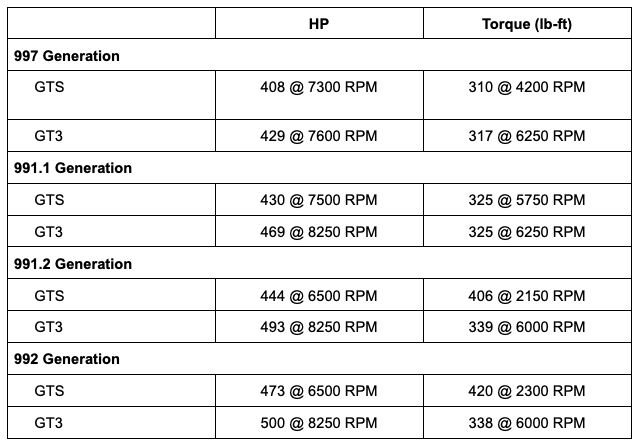
Comparing the 911 Carrera GTS with the 911 GT3
A common critique of the 911 model range focuses on the fact that so many different models exist. Porsche even produced a video in 2018 hoping to quickly explain the twenty-four derivatives they offered at the time.
When contemplating the various models in the 911 range, it’s helpful to consider the use case. Porsche has so many use cases covered in the modern 911; even one targeted for offroad use thanks to the Dakar.

While it’s far more common for buyers to cross shop the GTS with a Carrera S, comparisons between the GTS and GT3 are also made. Despite looking similar to the untrained eye, the GTS and GT3 are quite different, and one of the best ways to understand the differences is by considering their use cases.
When asked to compare the two models, most Porsche enthusiasts would offer a summary of the GTS as a street car confident on the track, and the GT3 as a track car tolerable on the street. This post will attempt to illustrate why this assertion is true by comparing the horsepower and torque specifications for the two cars.
The table below shows horsepower and torque for all 911 generations to date that include both a GTS and GT3.

In every generation, the GT3 produces more horsepower and at a higher RPM than the GTS. The higher horsepower aligns well with the GT3 billing as a track car tolerable on the street. Race cars prioritize horsepower, particularly in the higher RPM range, to achieve top speeds on straightaways and maximize overall performance. This design choice ensures engines capable of revving to high RPMs and producing substantial power output, optimizing top-end performance necessary to maintain high speeds on tracks with long straights.
In contrast, street cars prioritize torque, particularly in the lower RPM range, to optimize low-speed performance for everyday driving situations. Designers balance the curve to enhance low-end torque as this improves responsiveness and drivability, making street cars suitable for a wide range of driving conditions.
Comparing the torque of the two cars shows that the GTS produces essentially the same amount as or more than the GT3, and at a lower RPM. The difference is even more pronounced beginning with the 991.2 generation as the GTS was delivered with a turbocharged motor. Turbocharging allows the engine to generate more power from each combustion cycle, resulting in increased torque even at lower engine speeds. Turbocharged engines typically have a wider power band in comparison to naturally aspirated engines like those used in the GT3. This improved low-end torque enhances the acceleration and responsiveness, making the GTS more capable across the range of driving conditions more common on the street.
The GT3 race car vs. GTS street car is a popular comparison among automotive enthusiasts on YouTube. In a video by TheGetawayer, you can learn more from Guido about other differences between the GTS and GT3 that he found meaningful; and in Matt’s reviews on TheSmokingTire, he calls the the 991.2 GTS the “perfect road spec” and the 992 GTS the “perfect Porsche street car”.